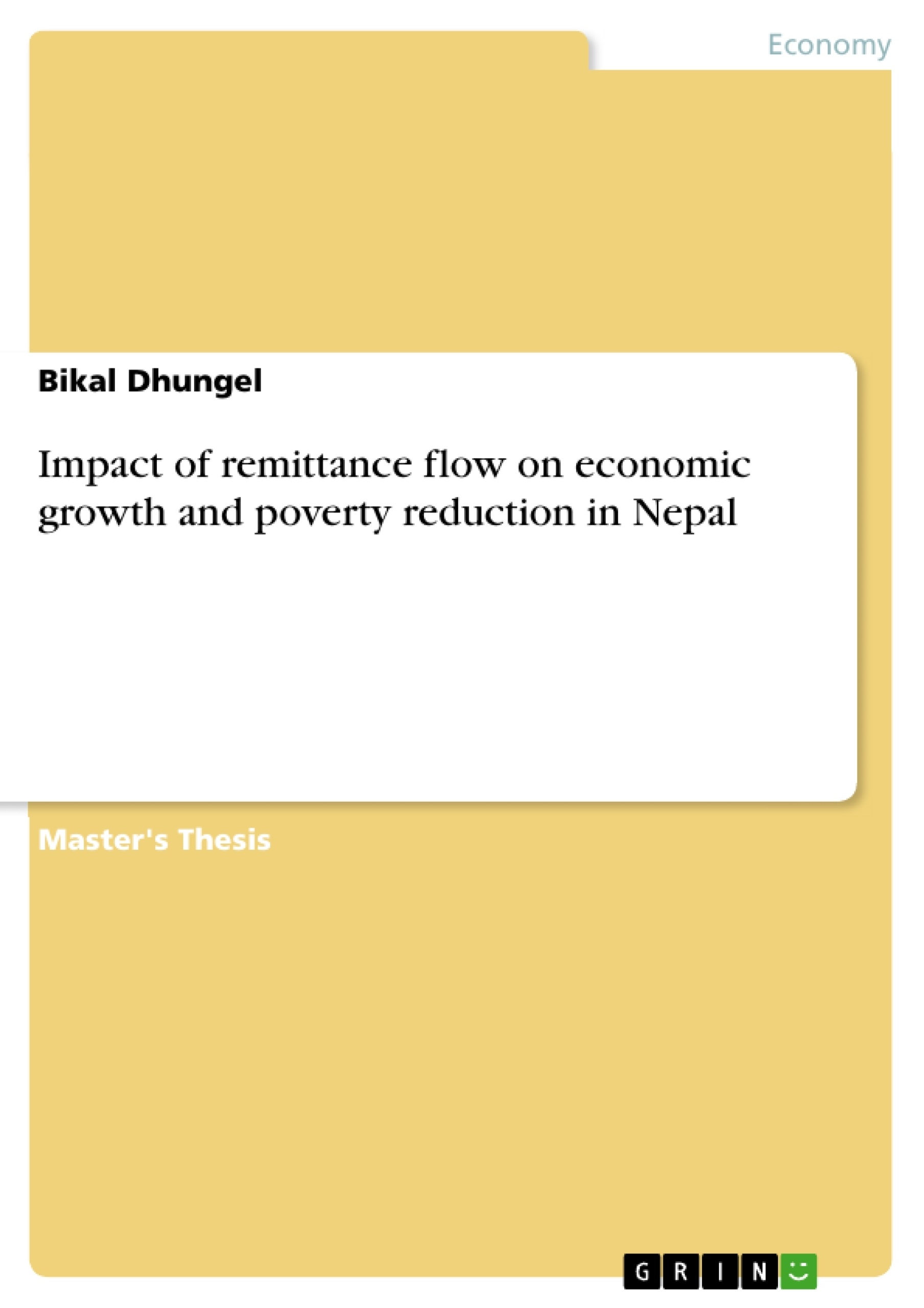This research uses time-series data to examine the impact of international remittance flow on economic growth and poverty reduction in Nepal. It applies the econometric model suggested by Ravallion (2001), Ravallion and Chen (1997) and Adam and Page (2005) for remittance and poverty and Quayyum et al (2008) for remittance and growth. Both micro and macro level impacts were considered. The regression results show that remittance flow is positively and significantly correlated with economic growth and poverty reduction in Nepalese context. The finding suggests that in the short run international remittance flow had positive contribution in economic growth and poverty reduction through investments in health, education and consumption. Remittance also contributed to relax credit constraints, especially for the poor and in macro level, helped to finance trade deficit, accumulate foreign exchange reserves and to reduce government debt. However, a deeper analysis of the last two decades shows that increased remittance flow has been the major cause of decline of tradable sector through „Dutch Disease‟ effects. Moreover, remittance contributed to higher inflation, eroded work habits and brought adverse social costs. Combined, the long term impact of remittance seems to be overwhelmingly negative in Nepal.
Inhaltsverzeichnis (Table of Contents)
- 1. Introduction
- 2. Theoretical Framework
- 3. Literature Review
- 3.1 Remittance and Growth
- 3.2 Remittance and Poverty Reduction
- 4. Background and Country Information
- 4.1 Economy and Poverty of Nepal
- 5. Methodology, Data and Results
- 5.1 Remittance and Poverty Reduction
- 5.2 Remittance and Growth
- 5.3 Regression of Remittance and Poverty Reduction
- 5.4 Regression of Remittance and Growth
- 6. Future Forecast
- 6.1 Remittance and Behaviour
- 7. Discussion
- 7.1 Positive Impacts
- 7.1.1 Micro Level
- 7.1.2 Macro Level
- 7.2 Negative Impact
- 7.1 Positive Impacts
- 8. Conclusion, Recommendation and Limitations
Zielsetzung und Themenschwerpunkte (Objectives and Key Themes)
This research aims to investigate the impact of international remittance flows on economic growth and poverty reduction in Nepal. Using time-series data and econometric modeling, it analyzes both micro and macro-level effects. The study considers both the short-term and long-term consequences of remittance inflows.
- Impact of remittances on economic growth in Nepal
- Effect of remittances on poverty reduction in Nepal
- Micro-level impacts of remittances (e.g., household investment, consumption)
- Macro-level impacts of remittances (e.g., trade balance, foreign exchange reserves)
- Potential negative consequences of remittances (e.g., Dutch Disease effects, inflation)
Zusammenfassung der Kapitel (Chapter Summaries)
1. Introduction: This chapter introduces the research topic, highlighting the significance of remittance flows in Nepal's economy and their potential impact on economic growth and poverty reduction. It outlines the research question, methodology, and the structure of the dissertation. The chapter establishes the context for the subsequent analysis and emphasizes the importance of understanding both the positive and negative consequences of remittances.
2. Theoretical Framework: This chapter lays the groundwork for the empirical analysis by presenting relevant theoretical models and concepts related to remittance flows, economic growth, and poverty reduction. It examines existing theories explaining the mechanisms through which remittances influence economic outcomes, drawing on established literature in development economics. The chapter provides the theoretical underpinnings that guide the interpretation of the empirical findings presented later in the dissertation.
3. Literature Review: This chapter reviews the existing literature on the impact of remittances on economic growth and poverty reduction, focusing on both general trends and specific studies related to Nepal. It synthesizes the findings of previous research to identify key debates and knowledge gaps that the current study seeks to address. The chapter's critical review of prior work contextualizes the present research within the broader academic discussion on remittances and their economic consequences.
4. Background and Country Information: This chapter provides essential background information on Nepal, focusing on the country's economic context and poverty levels. It describes the structure of the Nepalese economy, highlighting key sectors and challenges. The chapter also presents relevant data on poverty incidence, income distribution, and other socioeconomic indicators to provide the necessary context for understanding the impact of remittances within the specific socio-economic landscape of Nepal.
5. Methodology, Data and Results: This chapter details the research methodology, including the data sources, econometric models used, and the empirical results obtained. It explains the variables selected and the statistical techniques applied to analyze the relationship between remittance flows, economic growth, and poverty reduction. The presentation of the regression results forms the core of this chapter, with a detailed discussion of the statistical significance and interpretation of the findings.
6. Future Forecast: This chapter explores potential future trends in remittance flows to Nepal and their potential implications for the country's economy. It analyzes the factors that could influence future remittances, such as changes in global migration patterns or economic conditions in destination countries. This chapter presents a predictive analysis, though without concrete conclusions or a fixed timeframe, focusing on potential scenarios rather than definitive forecasts.
7. Discussion: This chapter discusses the findings of the study, exploring the implications of the empirical results and providing interpretations of the observed relationships between remittances, economic growth, and poverty reduction. It carefully weighs the positive and negative impacts, exploring the potential trade-offs and complexities involved. The chapter contextualizes the findings within the broader literature, drawing parallels and contrasts with other studies.
Schlüsselwörter (Keywords)
Remittances, economic growth, poverty reduction, Nepal, econometric modeling, time-series data, micro-level impact, macro-level impact, Dutch Disease, trade deficit, foreign exchange reserves, inflation.
Frequently Asked Questions: Impact of International Remittance Flows on Economic Growth and Poverty Reduction in Nepal
What is the main topic of this research?
This research investigates the impact of international remittance flows on economic growth and poverty reduction in Nepal. It analyzes both micro and macro-level effects using time-series data and econometric modeling, considering short-term and long-term consequences.
What are the key objectives and themes explored in this study?
The study aims to examine: the impact of remittances on economic growth in Nepal; the effect of remittances on poverty reduction in Nepal; micro-level impacts (household investment, consumption); macro-level impacts (trade balance, foreign exchange reserves); and potential negative consequences (Dutch Disease effects, inflation).
What is the structure of the research paper?
The paper is structured into eight chapters: Introduction, Theoretical Framework, Literature Review, Background and Country Information, Methodology, Data and Results, Future Forecast, and Conclusion, Recommendation and Limitations. Each chapter contributes to a comprehensive analysis of the research question.
What theoretical frameworks are used?
The research utilizes relevant theoretical models and concepts related to remittance flows, economic growth, and poverty reduction from established literature in development economics. These theories guide the interpretation of the empirical findings.
How does the study review existing literature?
A dedicated chapter reviews existing literature on the impact of remittances, focusing on general trends and studies related to Nepal. This synthesizes findings, identifies key debates, and highlights knowledge gaps addressed by this research.
What kind of data and methodology are employed?
The study uses time-series data and econometric modeling. The chapter detailing the methodology explains the data sources, models used, variable selection, and statistical techniques applied to analyze the relationship between remittances, economic growth, and poverty reduction.
What are the main findings and results of the study?
The core results are presented in the chapter on Methodology, Data and Results, with detailed discussion of statistical significance and interpretation. The Discussion chapter then explores the implications of these results, weighing positive and negative impacts.
What are the future forecasts regarding remittances in Nepal?
The Future Forecast chapter explores potential future trends in remittance flows to Nepal and their implications for the economy. It analyzes factors influencing future remittances, such as global migration patterns and economic conditions in destination countries.
What are the conclusions, recommendations, and limitations of the study?
The final chapter summarizes the study's conclusions, offers recommendations based on the findings, and acknowledges the limitations of the research, providing a balanced assessment of the work.
What are the key words associated with this research?
Key words include: Remittances, economic growth, poverty reduction, Nepal, econometric modeling, time-series data, micro-level impact, macro-level impact, Dutch Disease, trade deficit, foreign exchange reserves, and inflation.
- Citar trabajo
- Bikal Dhungel (Autor), 2015, Impact of remittance flow on economic growth and poverty reduction in Nepal, Múnich, GRIN Verlag, https://www.grin.com/document/323630




